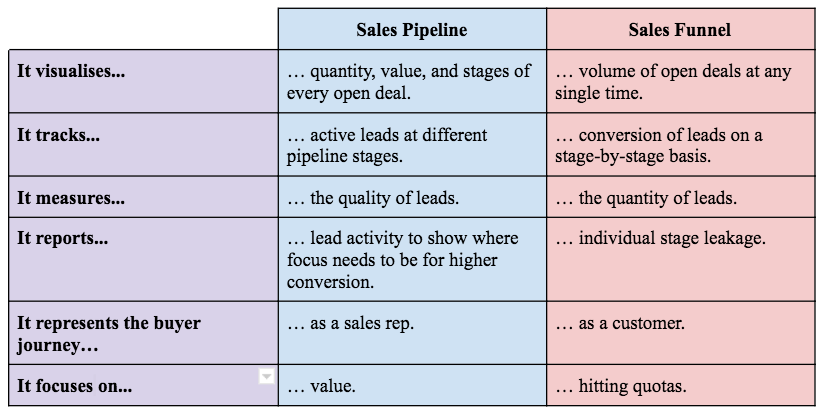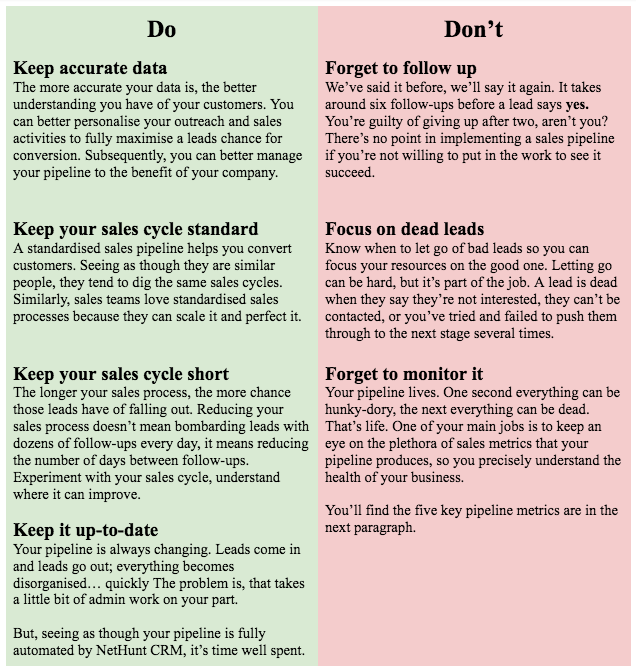How’s the pipeline looking? Wow... personal question.
Sales pipeline is one of those terms that gets bandied around a lot, and you’re just expected to know what it is. If you don’t, you came to the right place. We’ve got absolutely everything you need to know about sales pipelines. What it is. How to build one. Sales pipeline templates. Metrics to watch.
Let’s get growing.
What is a sales pipeline?
A sales pipeline is a visual snapshot made up of the different deal stages a lead goes through before they become a buyer. It’s a simple tool to help businesses get organised, prevent any leads from falling through gaps, and maximise profits. It’s essential for salespeople as they juggle multiple deals at one time; it gives them an overview of all their leads, which concrete actions need to be completed, and how valuable that lead is for their business.
Sales processes differ from company to company, and so each sales pipeline should be unique to each business. Here’s a very general sales pipeline to show you what we mean.

Sales pipelines are popular in B2B sales, where sales cycles can be particularly long. But, they are also becoming more en vogue in B2C sales. No matter what business niche you sit in, a sales pipeline will...
- Improve your sales process.
- Provide accurate business forecasts.
- Provide accurate, automatic sales reporting.
- Offer insights into the success of different sales strategies.
- Allow you to allocate resources where they need allocating.
- Help you provide a more accurate, personalised outreach.
- Help you get on top of your deals and data.
- Align messaging and outreach between different teams.
- Prevent leads from falling off course.
In short, a healthy pipeline is a healthy business.
What’s the difference between sales pipeline and sales funnel?
It’s clear that a lot of people don’t know the difference, even as they write thousand-word articles trying to explain it. The two terms are often used interchangeably, but this is a mistake. The most obvious way to tell the difference is obviously by looking at the shape. A sales funnel is wide at the top and narrow at the bottom; a pipeline’s sides stay parallel all the way along. Beyond that it’s confusing because they both do the same things, but in different ways.
Confused? The following table should help break it down a little bit.

As you can see, the sales funnel is about leads; the sales pipeline is about deals. A sales funnel is the sales process stages which a lead travels through before converting, but a pipeline comprises every stage in the sales process which a sales rep takes to move a deal from start to close. A pipeline reflects what a seller does during the sales process, but a funnel measures conversion rates through the sales process.
How to Build a Sales Pipeline.
I imagine the process of building a sales pipeline as something like building a campfire. You have to collect a few things beforehand. But instead of firewood, you need a list of prospects, an idea of what your sales process is, a list of revenue targets, and your team.
- A detailed sales process
Your sales process is a structured breakdown of which activities your team needs to complete before they close a deal. This is what your pipeline viusalises. Once you find a sales process that works for your business, your pipeline won’t change and sales reps can repeatedly fulfill the same activities for each individual sale. If you don’t have an organised sales process, you pipeline won’t work. - A list of prospects
Your prospects are the people who (hopefully) are going to buy a product from you; the ones who will be in your pipeline. Before you build a list of prospects, you need a detailed buyer profile to know who to target and a platform with which you can reach out to them. For inbound sales, make sure you have access to at least a name, contact info, the company they work for, and their position after they fill out that form on your website.
For outbound sales, your best bet is LinkedIn. It’s a professional social media platform with every bit of data you need to reach out to people who are expecting to be reached out to. NetHunt’s LinkedIn Sales Navigator integration scrapes all that juicy data from a connection’s profile, plonking it right in your CRM dashboard and onto your sales pipeline!
Find out more about NetHunt’s LinkedIn integration.
- Some revenue targets
A sales pipeline is going to help ensure you meet your sales goals. You need to build your pipeline so it is geared towards meeting those goals. Your revenue targets will help you ask yourself all the right questions for your sales pipeline.
With proper pipeline management, you’ll quickly understand how many deals you need to be added to the top of the pipeline to reach your goals at the bottom of it.
How many deals do we need to close in order to hit our target?
What’s the average amount of time it takes for a deal to close?
How many leads do I need at the start, in order to close at the end?
- Your team
If your pipeline is any good, everybody will use it. Principally, it’ll be the sales team who are using it to complete their work. It’s important that they have a say in how it’s built; they know the sales process. It can also be worth having your marketing and customer success teams have access to the pipeline. Inter-team alignment is never a bad thing, messaging becomes unified and the whole buyer journey can become even shorter.
You’ve got all your firewood. It’s time to build a fire.
Sales Pipeline Template
There are two ways to build an effective, centralised pipeline for your business. NetHunt have sorted both ways for you. The first is to download our free pipeline spreadsheet template. Sure, you can tediously log each detail of your deal, push them through the pipeline yourself, and tear your hair out at some pretty inflexible Excel formulas.
Sure, if you want that. Download it here!
Alternatively... that sounds rubbish. Manual data sucks bad. If you don’t want to start from scratch, choose a CRM software. NetHunt is a Gmail CRM that gives you a pre-set pipeline which is fully customisable to your needs… right inside your Gmail inbox. It allows users to filter out unnecessary information and create custom views that they can save and access later in one click. Go on, start your 14-day free trial today!
The Dos and Don’ts of Building a Pipeline
Now, we’re not your mum. We’re not telling you what to do. We’re pipeline experts, and we’re telling you that we’ve seen hundreds of pipelines fail and succeed in our time. People make the same old mistakes when they’re building their pipelines, and we don’t want you to do the same.
Alas, do the green things. Don’t do the red things.

Again, that’s do the green things. Don’t do the red things.
Making Sure your Pipeline is Successful.
With a dedicated pipeline CRM in place, managing your sales pipeline becomes easy. Automatic even. You can do things like set alerts for when a lead has lingered in one stage for too long and fire out an automated, templated email to give them a nudge. You’ll also have access to automated pipeline reporting features, which will help you to know exactly what is going on with your business.
Here are the five pipeline metrics that you can’t afford not to monitor.
- # Newly Qualified Leads per [time]
You can’t have a pipeline without good leads in it. The very first metric that needs to be monitored is the amount of leads who are ready to buy your product that enter your pipeline. This is measured by counting who moves into the qualified stage of your pipeline, and tells you how effective sales activities are at attaining new leads, and whether there is enough forecasted revenue to hit your goals. - # Meetings Booked
The next metric you should monitor is how many meetings have been booked between reps and potential clients. On your pipeline, this is the leads who are moving through to the meeting stage. It’s important because it gives us a glimpse of the amount of serious sales opportunities that are actually in the pipeline. These leads are generally towards the end of your pipeline. A meeting means interest. - Average Sales Cycle
Your average sales cycle is the amount of time it takes for a lead to move from the first contact they have with your business, all the way to actually buying something. This metric helps you better understand when a deal is stagnant; when it has been in the pipeline for too long. For example, if you close 40 deals in 100 days, then your average sales cycle is 2.5 days. Calculating the average sales cycle is easy.
PERIOD OF TIME / NUMBER OF CLOSED DEALS = AVERAGE SALES CYCLE - # New Deals Closed
A closed deal is what you want. A closed deal is what makes the good stuff… revenue. Monitoring this metric offers sales leaders a granular insight into the strengths and weaknesses of a sales team, their pipeline, and the sales process that makes it up. With an eye on closed deals, you can understand who your top performers are, whether deals are stalling in the pipeline, and whether more training is needed. - % Win Rate
Your win rate is the percentage of leads that travel all the way through your pipeline to conversion. It’s the holy grail of pipeline metrics, and the higher this number is... the better your sales team is. For example, if 100 leads enter your pipeline and you win five deals, your win rate is 5%. Again, win rate is super easy to calculate.
(NEW LEADS / NUMBER OF CLOSED DEALS) x 100 = WIN RATE
The Final Word
A campfire needs to be topped up regularly with fuel. The final word I'll say for this tedious metaphor is that a pipeline is the same. Keep it topped up with fresh, quality leads and you’ll keep the lights on and the whole camp fed.
If you want a fully automated pipeline inside a powerful Gmail CRM system, give NetHunt a try.
Table of Contents
Crack the sales formula with CRM Lab
Twice a month, receive actionable CRM content to your inbox.

